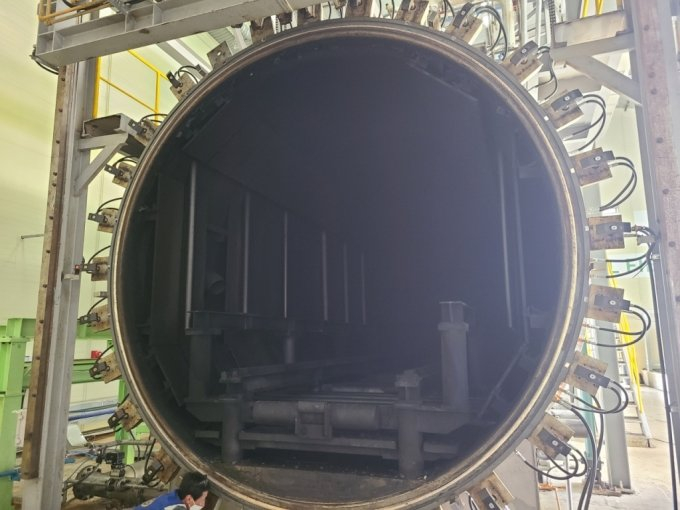 Inside of eco-friendly waste processing machine of City Oil Field. Ceramic ball is used. Photo= City Oil Field
Inside of eco-friendly waste processing machine of City Oil Field. Ceramic ball is used. Photo= City Oil FieldReduction of greenhouse gas emissions determines the life of all people as it has impact on the way of production and consumption and jobs. Therefore, the government is concerned about the damage on the industry and people are worried more about immediate income decrease and unemployment than the quality of air in 2050. However, if we change our perspective, climate crisis is a great investment opportunity and an opportunity for leap forward. In the times of crisis, there have been people and companies who challenged and overcame the crisis and created a new order. New and groundbreaking technologies are required to achieve Net Zero by 2050.
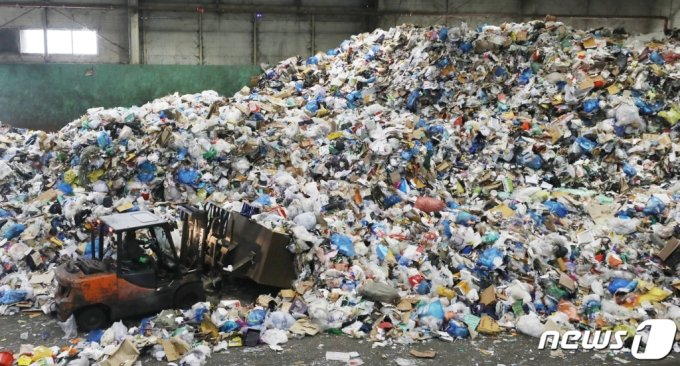 (Seoul=News1) Reported by Song Won-young = On the afternoon of 16th, employees are sorting disposable recyclables at the Songpa Resources Park. The amount of waste is on the increase due to increased use of disposable products with sharp increase in the use of food delivery service and parcel delivery. Feb. 16, 2021/News1
(Seoul=News1) Reported by Song Won-young = On the afternoon of 16th, employees are sorting disposable recyclables at the Songpa Resources Park. The amount of waste is on the increase due to increased use of disposable products with sharp increase in the use of food delivery service and parcel delivery. Feb. 16, 2021/News1Most of the waste on land and sea is plastic or vinyl, which is made from fossil fuels. Many countries studied emulsification technology to decompose the waste chemically into raw materials or oil, and applied the technology to the industry, the technology has limitation of wide application due to generation of environmental pollutants and high cost.
"Turning products made of oil back to oil"If emulsion reduction of waste plastics is possible at a low temperature, the problem of pollutant generation and high cost is solved. There is a company that has developed the ultimate reduction technology that reduces low grade waste based on carbon such as waste plastics and waste vinyl into original form of oil using wave energy.
이 시각 인기 뉴스
City Oil Field, which successfully developed fuel reduction device for ships 10 years ago, developed proprietary technology that decomposes waste plastics in an eco-friendly way using wave decomposition (using heat and the third wave), not pyrolysis (separation using only heat) for the first time in the world.
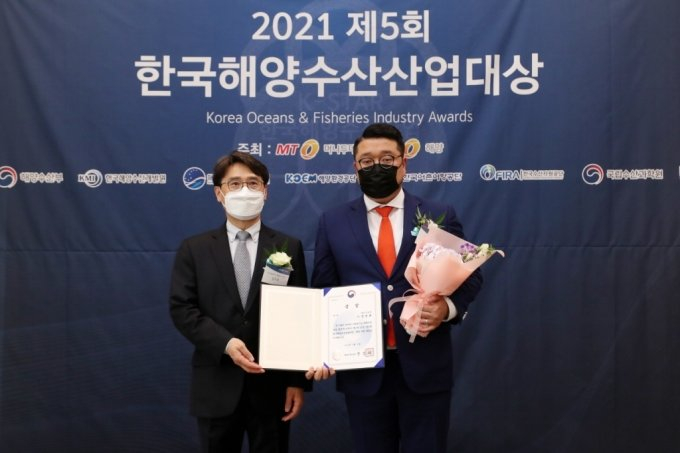 CEO Jung Young-hoon of City Oil Field (right) won the award from the Minister of Oceans & Fisheries at the Korea Oceans & Fisheries Industry Awards/ photo= Money Today
CEO Jung Young-hoon of City Oil Field (right) won the award from the Minister of Oceans & Fisheries at the Korea Oceans & Fisheries Industry Awards/ photo= Money TodayMoney Today recognizes that the new technology developed by City Oil Field is a proprietary technology that has not been developed by other countries and it has high ripple effects so it decided to advertise the technology actively at home and abroad. First, Money Today introduces the process of 'turning the products made of oil back to oil', value of the technology and vision of City Oil Field in two parts based on the interview with CEO Jung Young-hoon, director Han Dong-hyeon of Business Division and advisor Park Gyeong-min of City Oil Field.
Interview was conducted by executive director Yoon Byeong-hoon of New Media Division of Money today and CEO of eroun.net and editor in chief Kim Kyu-tae of eroun. Net and editor Shin Jae-eun of Money Today were present during the interview on May 17. 2021. Interview was conducted in the form of free discussion based on questions and answers shared before the interview and organized as follows.
1-1. Principle of waste plastic decomposition technology using wave energy
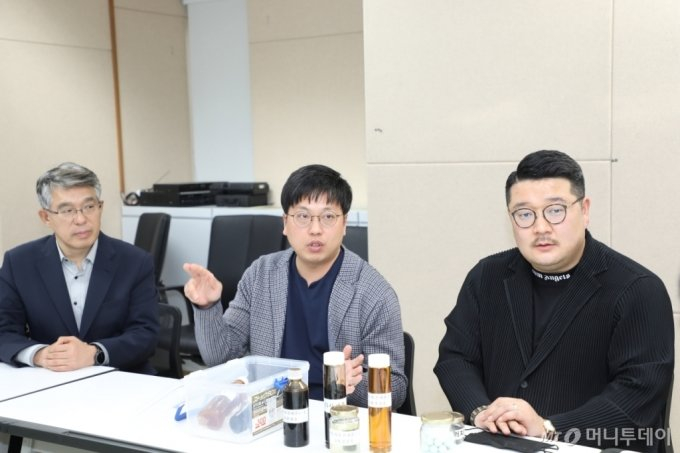 (From the left) Advisor Park Gyeong-min, Director Ham Dong-hyeon of Business Division, CEO Jung Young-hoon of City Oil Field= Photo= Money Today
(From the left) Advisor Park Gyeong-min, Director Ham Dong-hyeon of Business Division, CEO Jung Young-hoon of City Oil Field= Photo= Money TodayThe method of inducing a certain movement of molecules by breaking molecular bonding structure with wave energy is similar to the principle of microwave oven. To understand the waste plastic decomposition technology using wave energy, we need to understand the concept of wave, radiation, electromagnetic wave, wave energy, resonance frequency and ceramic first.
1-2. Vibration of molecules, absorption and release of energyHigh pitched tone of soprano's voice may break the class. This is because the unique frequency of the glass and the sound frequency of a singer resonate, making the molecules of the glass vibrate actively and it hard to maintain the bonding.
The various kinds of movements in the molecule is the absorption and release of different kinds of energy. In general, the frequency absorbed by a molecule is equal to the frequency of electromagnetic wave released when the molecule is activated. The relationship between the absorption and emission is called Kirchhoff's law. The boundary of the frequency band is not defined clearly.
The emission of energy in the form of waves or particles is called radiation. The energy emitted in this way is radiant energy. Energy delivered in the form of wave such as electromagnetic wave and gravitational wave and the energy in the form of particles such as alpha and beta are all radiant energy.
In many cases, radiant energy is regarded as the same as energy of electromagnetic waves or electromagnetic waves themselves. Higher energy means that the radiant energy is bigger than the ionization energy of the molecules constituting the material. The electrons that scatters nuclei of molecules are easily ionized to break the bonding of molecules, resulting in other molecules.
The chemical phenomenon, which breaks chemical bonds, seems to occur by the action of force but it occurs due to the interaction of vibrational energy. The substances that seem colorless to our naked eyes like water absorbs vibration of various frequencies invisible to our eyes constantly. A certain movement starts within molecules by the absorbed energy. Microwave ovens also use the interaction between microwaves and water molecules.
1-3. Frequency of wave energy, the principle of microwave ovenMicrowave has a frequency (frequency, the number of vibrations per second) of 300 MH to 300 GHz and a wavelength of 1 mm to 1 m, which has a lower frequency and longer wavelength than light. But it has higher frequency and shorter wavelength among radio waves (with wavelengths below infrared rays), it is used for radar and communications.
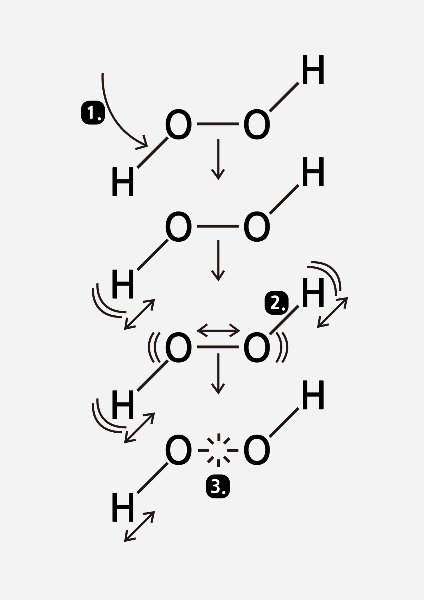 Experiment of Freming and Cream, Wisconsin University. When laser ① of a specific frequency is radiated to the molecule of hydrogen peroxide, the energy is absorbed by oxygen-hydrogen bonding② of hydrogen peroxide molecules, generating violent vibration. The vibration is delivered to the whole molecules, and oxygen-oxygen bond ③, which has weaker bonding power than oxygen-hydrogen bond, is broken.
Experiment of Freming and Cream, Wisconsin University. When laser ① of a specific frequency is radiated to the molecule of hydrogen peroxide, the energy is absorbed by oxygen-hydrogen bonding② of hydrogen peroxide molecules, generating violent vibration. The vibration is delivered to the whole molecules, and oxygen-oxygen bond ③, which has weaker bonding power than oxygen-hydrogen bond, is broken.Microwave passes through the matters such as glasses, paper and plastics but it interacts with molecules such as water, sugar and fat to separate the bond of molecules, accelerating the rotation of molecules or interfering with the movement of molecules, inducing collision to generate heat or heat the materials inside.
It is said that when two energies resonate and start exchanging vibrational energy, crystalline materials such as shells or stones increase the vibrations further.
2-1. Ceramic
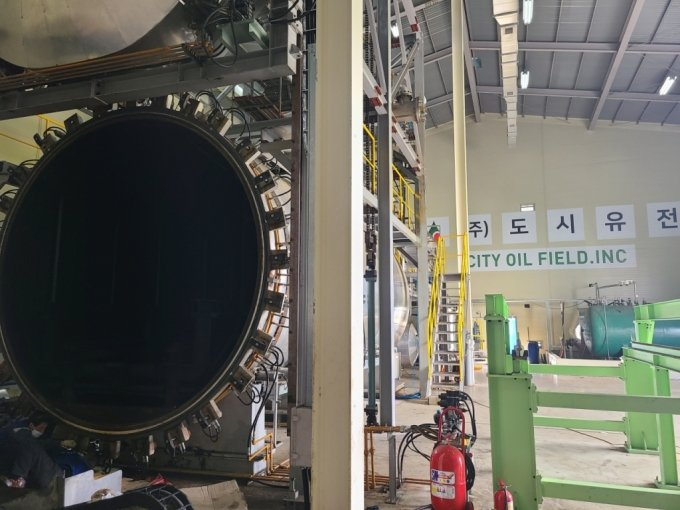 Photo of waste processing machine of City Oil Field/Photo=City Oil Field
Photo of waste processing machine of City Oil Field/Photo=City Oil FieldLike the principle of microwave ovens, it is possible to break the bond of plastic molecules by irradiating wave energy with the same frequency as the that of carbon bonding molecules in plastics made of oil. It is to turn the petrochemical products back to oil again. Many resources in many countries around the world have studied this technology but have not succeeded. But City Oil Field successfully turned the waste plastic into oil using unique wavelength that was found by heating ceramic rod using electricity.
Ironically, the idea of 'turning the waste plastics back to oil using wave energy (far-infrared rays) emitted from ceramic rod' started from the inquiry of existing pyrolysis company. The company asked if there is a way to solve the problem of waxing phenomenon of oil produced by domestic pyrolysis company. Jung Heung-je, a father of CEO Jung Young-hoon of City Oil Field, developed ceramic technology for the first time. The origin of the technology is the fuel reduction device for ships. The principle is that when heavy crude oil (bunker C oil) used for ship fuel is exposed to wave energy radiated from ceramic road, it is instantly converted into light oil.
Currently, ships in Busan are actually use this fuel use reduction device to reduce fuel cost and contributes to the protection of the marine environment. City Oil Field successfully liquified solidified oil using ceramic rod. The same test was conducted on plastics and it successfully turned the plastic back to oil.
Q. Is there any harm related to the method of decomposition using wave?
City Oil Field possesses proprietary technology using the eco-friendly way of decomposition with wave, not using pyrolysis technology. Therefore, the whole process temperature does not go over 300℃. It means that the temperature does not exceed 300℃, the point when harmful substances occur. So, it is possible to decompose and process waste plastics using wave while preventing the generation of harmful substances to the environment.
Q. How is the paper and general waste that is put together without pre-treatment process treated?
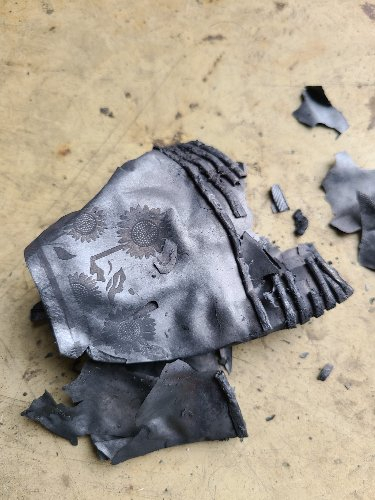 Waste (paper cup) processed by City Oil Field's machine/Photo= City Oil Field
Waste (paper cup) processed by City Oil Field's machine/Photo= City Oil Field2-2. Recognition and application of the technology-Korea Midland PowerQ. It is said that the City Oil Field's technology is well recognized by many institutions
City Oil Field signed an MOU in a non-face-to-face manner for 'the upgrading and utilization of oil regenerated from waste resources' to solve the problem of waste including waste plastics and waste vinyl with Korea Midland Power, Korea Environment Corporation and Sudokwon Landfill Site Management Corporation.
According to the four-party agreement, Korea Midland Power is in charge of reviewing the usability of oil regenerated from waste resources such as waste plastics and waste vinyl in power generation, direct purchase and sales channel expansion and Korea Environment Corporation supports the research and sophistication of oil regenerated from waste resources. Sudokwon Landfill Site Management Corporation is making an effort to improve the technology to turn waste into resources by operating research facilities and joint research. City Oil Field is making an effort to the supply of equipment where eco-friendly waste resource treatment technology is applied and regenerated oil on the market.
Korea Midland Power said that the oil extracted using 'eco-friendly waste plastic decomposition and treatment technology using ceramic wave' of City Oil Field was suitable for ships and industry. It means that the oil produced by treating waste plastics at City Oil Field is high quality oil that cannot be made by existing pyrolysis companies.
The oil produced by City Oil Field was collected by INFINEUM, a global petrochemical company and Korea Midland Power and internal quality test was conducted by the companies. The results were amazing. INFINEUM concluded that the primary heavy crude oil of City Oil Field was suitable for marine ships and the secondary refined oil was kerosene grade in the test report and the report was shared. Korea Midland Power tested and reviewed the usability of the oil as the fuel for boiler startup and then signed the 4-party MOU on the17th.
2-3. Cambridge University, iQ international AG, OCI, INFINEUM, China National General Machinery Engineering CorporationQ. What is the reaction in other countries?
In Feb., last year, Melville Laboratory of Cambridge University, UK established a research center for joint research with City Oil Field within the Cambridge University with the Cambridge University subsidy of £100,000 (KRW 160 million) for research. City Oil Field is planning to publish the results of study conducted jointly by the Cambridge University research center in international science journals such as Nature.
In addition, City Oil Field is exploring opportunities to enter the US market with equity investment from iQ International AG, which has headquarters in Zug, Switzerland and conducts environmental business through sustainable technologies in the US, and joint partnership.
City Oil Field has secured the possibility to use even the remnants after the treatment as high-quality solid fuel. OCI, which develops eco-friendly chemical materials, is analyzing solid fuel extracted from City Oil Field.
China is very active for the technology of City Oil Field. China National General Machinery Engineering Corporation under the State Council of People's Republic of China and City Oil Field signed an agreement to promote the project to solve the problems of waste vinyl and waste plastics in China jointly in last March.
* The benefits of decomposition technology using wave, comparison with similar environmental technologies at home and abroad, significance of City Oil Field's technology and corporate vision will continue in Part 2.
